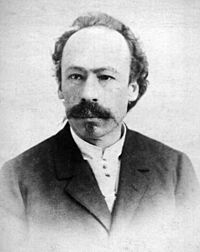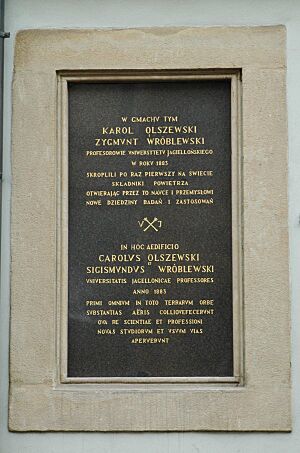Karol Olszewski facts for kids
Quick facts for kids
Karol Olszewski
|
|
|---|---|

Karol Olszewski
|
|
| Born |
Karol Stanisław Olszewski
29 January 1846 Broniszów, Galicia
|
| Died | 24 March 1915 (aged 69) Kraków, Galicia
|
| Nationality | Polish |
| Education | Jagiellonian University in Kraków Heidelberg University PhD |
| Occupation | Scientist |
| Known for | First to liquefy oxygen and nitrogen. First Polish X-ray Photographs |
| Title | Professor |
Karol Stanisław Olszewski (born 29 January 1846 – died 24 March 1915) was an important Polish scientist. He was a chemist, a mathematician, and a physicist. Along with Zygmunt Wróblewski, he was the first person in the world to turn oxygen and nitrogen into liquids in 1883. This was a huge step forward in science!
Contents
Early Life and Education
Karol Olszewski was born in 1846 in a place called Broniszów. He went to high school in Tarnów. Later, he studied at Kraków's famous Jagiellonian University. There, he focused on mathematics, physics, chemistry, and biology.
He started doing his own experiments early on. He even improved a special machine called a compressor. He used it to squeeze and turn carbon dioxide into a liquid.
Groundbreaking Discoveries
Olszewski earned his PhD from Heidelberg University in Germany. After that, he came back to Kraków. He became a professor at the Jagiellonian University.
Liquefying Gases
In 1883, something amazing happened. Karol Olszewski and Zygmunt Wróblewski worked together. They were the first scientists ever to successfully turn oxygen and nitrogen into stable liquids. They also liquefied carbon dioxide from the air. Before this, these gases could only be liquid for a very short time. Their discovery opened up new ways to study and use these elements.
A year later, in 1884, Olszewski made another big breakthrough. In his lab in Kraków, he was the first to turn hydrogen into a liquid. He reached an incredibly cold temperature of about -225 degrees Celsius (which is 48 Kelvin). This was a record at the time! In 1895, he also managed to liquefy argon. The only gas he couldn't turn into a liquid was the newly found element, helium.
Pioneering X-ray Photography
In January 1896, Olszewski heard about Wilhelm Röntgen's new discovery: X-rays. He quickly set up his own equipment. Within just a few days, he was able to create X-ray images himself.
Soon after, in early February, he took an X-ray picture of a dislocated elbow. This was a very important moment. It helped start the university's department of radiology. This is where doctors use X-rays to see inside the body.
Later Life and Legacy
Karol Olszewski passed away on 24 March 1915. He was first buried in the Rakowicki Cemetery in Kraków. Later, in 2018, his remains were moved. They are now in one of Poland's National Pantheons. This special place is at the Church of Saints Peter and Paul in Kraków's Old Town.
A famous physicist named Andrzej Kajetan Wróblewski believes Olszewski is one of the greatest Polish physicists of the 20th century. He is mentioned alongside other brilliant minds like Marie Curie.
See also
- Timeline of low-temperature technology
- Timeline of hydrogen technologies
- List of Poles


